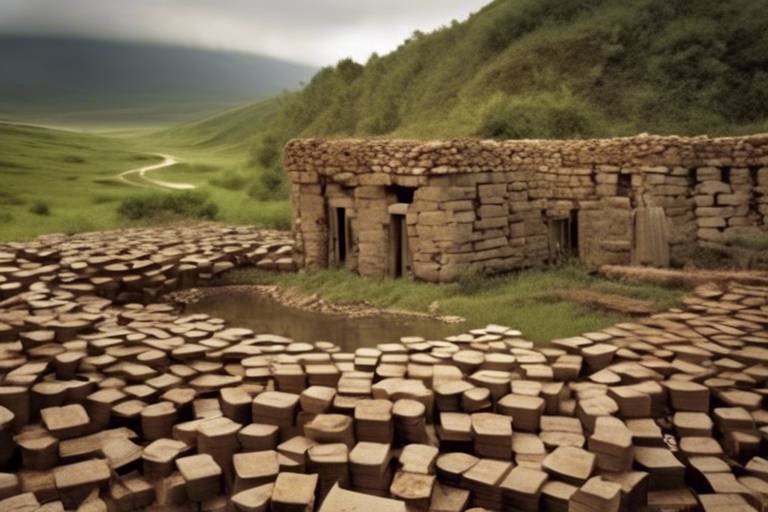Understanding the Challenges of Heritage Preservation
In the realm of heritage preservation, numerous challenges loom large, casting shadows over the efforts to safeguard our shared cultural legacy. These challenges span from financial constraints to environmental threats, legal complexities, and societal dynamics. Each obstacle presents a unique hurdle that must be navigated with care and innovation to ensure the protection and longevity of our heritage sites.

Lack of Funding for Preservation Projects
Preserving our cultural heritage is a noble endeavor, but it often comes with a hefty price tag. The lack of adequate funding for preservation projects poses a significant challenge to the maintenance and restoration of historical sites. Without sufficient financial resources, many heritage sites are left vulnerable to neglect and deterioration, putting our cultural legacy at risk.

Urban Development Pressures
When it comes to preserving our cultural heritage, one of the biggest challenges we face is the relentless pressure of urban development. As cities expand and populations grow, the demand for space often leads to the destruction or alteration of historic buildings and landscapes. The rapid pace of urbanization can threaten the very essence of heritage sites, putting their integrity at risk.
Imagine a bustling city where towering skyscrapers overshadow centuries-old structures, where modernity clashes with history in a constant battle for space. The allure of progress often comes at the expense of our past, as heritage sites become casualties of urban sprawl. The delicate balance between development and preservation is a tightrope walk, where one wrong step can erase a piece of our collective history forever.
Efforts to protect these sites from the bulldozers of progress are met with resistance, as economic interests often take precedence over cultural significance. The clash between the old and the new creates a battleground where the victor determines what remains standing and what is lost to the annals of time.

Climate Change Impacts
Preserving cultural heritage is a vital endeavor that requires overcoming various obstacles to ensure the protection and conservation of valuable historical sites and artifacts. In this article, we will delve into the key challenges faced in heritage preservation and explore innovative solutions to safeguard our rich cultural legacy.
Climate change poses a significant threat to heritage structures and artifacts worldwide. The increasing frequency and intensity of extreme weather events, such as hurricanes, floods, and wildfires, can wreak havoc on vulnerable historical sites, accelerating their decay and risking irreversible damage. Rising sea levels further endanger coastal heritage, putting iconic landmarks at risk of submersion and erosion.
Moreover, the shifting climate patterns can disrupt the delicate balance of ecosystems surrounding heritage sites, leading to the deterioration of cultural landscapes and the loss of biodiversity. The impact of climate change on heritage preservation is profound, necessitating proactive measures to mitigate risks and adapt to the evolving environmental conditions.
One innovative approach to addressing climate change impacts on heritage preservation is the integration of sustainable practices in conservation efforts. Implementing eco-friendly strategies, such as using renewable energy sources, promoting water conservation, and adopting green building techniques, can help reduce the carbon footprint of preservation projects and enhance the resilience of heritage structures against environmental threats.
Furthermore, leveraging digital technologies like 3D scanning and virtual reality modeling enables accurate documentation and monitoring of heritage sites, facilitating the assessment of climate-induced damages and the development of tailored conservation plans. By harnessing the power of data analytics and remote sensing, preservationists can anticipate climate change effects and implement timely interventions to safeguard cultural heritage for future generations.

Legal and Regulatory Issues
When it comes to preserving our cultural heritage, legal and regulatory issues play a significant role in shaping the landscape of heritage conservation. Navigating through a maze of laws and regulations can be daunting for organizations and individuals alike, creating hurdles that impede the smooth progress of preservation projects.
One of the main challenges in heritage preservation is the clash between property rights and heritage protection. Property owners may have conflicting interests with heritage conservationists, leading to disputes over the use and development of historical sites. Balancing the need to respect property rights while safeguarding our shared heritage requires careful negotiation and legal expertise.
Furthermore, the lack of uniformity in heritage protection laws across different regions can complicate preservation efforts. Each jurisdiction may have its own set of rules and guidelines, making it challenging for stakeholders to navigate the legal landscape effectively. This diversity in regulations underscores the importance of legal professionals and experts in heritage preservation projects.
Additionally, compliance with regulatory requirements can be a time-consuming and costly process for heritage conservation initiatives. Obtaining permits, conducting environmental impact assessments, and meeting heritage standards all add layers of complexity to preservation projects. The bureaucratic hurdles involved in regulatory compliance can slow down the pace of conservation efforts and strain the resources of organizations dedicated to heritage preservation.
In response to these challenges, collaboration between legal experts, heritage professionals, and community stakeholders is essential. By working together, these diverse groups can develop innovative solutions to legal and regulatory obstacles, ensuring that our cultural heritage is protected for future generations. Through a collective effort to address legal issues, we can pave the way for more effective and sustainable heritage preservation practices.

Public Awareness and Engagement
Public awareness and engagement play a vital role in the preservation of our cultural heritage. By educating communities about the significance of historical sites, we can instill a sense of pride and responsibility in protecting these valuable assets for future generations.
One effective way to raise awareness is through interactive workshops and educational programs that highlight the historical and cultural importance of heritage sites. Engaging with local schools, universities, and community groups can spark interest and involvement in preservation efforts.
Furthermore, leveraging digital platforms and social media channels can amplify outreach efforts, reaching a wider audience and generating support for heritage conservation projects. Sharing captivating stories and engaging visuals can captivate the public's interest and inspire them to take action.
Collaborating with local influencers, historians, and cultural experts can also enhance public engagement by providing unique insights and perspectives on the value of preserving heritage sites. Their expertise can help bridge the gap between the past and the present, making history come alive for audiences.
Creating partnerships with heritage organizations, museums, and government agencies can further strengthen public engagement initiatives. By joining forces and pooling resources, we can collectively work towards raising awareness, advocating for preservation policies, and mobilizing community participation in heritage conservation.
Ultimately, fostering a sense of ownership and connection to our shared heritage is essential in ensuring its long-term protection and sustainability. By engaging the public in meaningful ways, we can cultivate a culture of preservation that celebrates our diverse history and enriches our collective identity.

Technological Advancements in Preservation
When it comes to preserving our rich cultural heritage, technological advancements play a pivotal role in revolutionizing the way we document, analyze, and safeguard historical sites. One of the most groundbreaking tools in heritage preservation is 3D scanning technology. By capturing detailed three-dimensional images of structures and artifacts, 3D scanning allows for precise documentation and virtual preservation of heritage sites. This not only aids in the conservation efforts but also provides a valuable resource for researchers and historians to study and understand these sites in intricate detail.
Moreover, digital mapping technologies have transformed the way we explore and protect heritage landscapes. Through satellite imaging and Geographic Information Systems (GIS), experts can create comprehensive maps that highlight vulnerable areas, monitor changes over time, and plan conservation strategies effectively. These digital tools not only streamline the preservation process but also enable a more proactive approach to safeguarding our cultural legacy.
Furthermore, the integration of virtual reality (VR) and augmented reality (AR) applications has opened up new possibilities for engaging the public in heritage preservation. Virtual tours and interactive experiences allow individuals to immerse themselves in historical settings, fostering a deeper connection with the past and promoting appreciation for our shared heritage. By leveraging these innovative technologies, conservationists can bridge the gap between traditional preservation practices and modern digital solutions, ensuring the long-term protection of our cultural treasures.
In addition to these advancements, the use of drones for aerial surveys and monitoring has revolutionized the way we assess heritage sites from above. Drones provide a bird's-eye view of inaccessible or hard-to-reach areas, enabling experts to identify potential risks, assess structural integrity, and detect signs of deterioration without disturbing the site itself. This non-invasive approach not only enhances the efficiency of conservation efforts but also minimizes the impact on fragile heritage structures.
Overall, technological advancements in preservation have not only enhanced the documentation and conservation of heritage sites but have also democratized access to our shared history. By embracing these cutting-edge tools and techniques, we can ensure that future generations inherit a world rich in cultural diversity and historical significance.

Collaboration with Indigenous Communities
Preserving cultural heritage goes beyond physical structures; it involves respecting and involving indigenous communities in the conservation process. Indigenous peoples hold valuable knowledge about the history and significance of heritage sites, making their collaboration essential for preserving heritage in a culturally sensitive and sustainable manner.
By engaging with indigenous communities, conservation efforts can benefit from traditional practices and insights that have been passed down through generations. This collaboration fosters a deeper connection to the land and heritage, ensuring that preservation initiatives align with the values and beliefs of the communities directly affected by them.
Moreover, involving indigenous groups in heritage preservation projects can empower them to take an active role in safeguarding their cultural legacy. This not only strengthens community ties but also contributes to the long-term sustainability of conservation efforts by creating a sense of shared responsibility and ownership.
Through meaningful partnerships with indigenous communities, heritage preservation can transcend mere physical conservation and become a collaborative process that honors the diverse cultural heritage of the past while shaping a more inclusive and equitable future.

Tourism and Overcrowding
Tourism plays a significant role in promoting cultural heritage sites, attracting visitors from around the world to experience the richness of history and architecture. However, the popularity of these destinations often leads to challenges related to overcrowding and overuse. The delicate balance between encouraging tourism for economic benefits and ensuring the preservation of heritage sites is a complex issue that requires careful planning and management.

Heritage Preservation in Conflict Zones
Preserving cultural heritage in conflict zones presents a unique set of challenges that require delicate handling and specialized strategies. The turmoil of war not only endangers human lives but also puts historical sites and artifacts at risk of destruction, looting, and deliberate targeting. The chaos and violence in conflict areas make it difficult to prioritize heritage preservation amidst immediate humanitarian concerns.
One of the key issues in conflict zones is the lack of resources and infrastructure to protect heritage sites. The focus is often on ensuring the safety and well-being of the population, leaving little capacity to safeguard historical treasures. Moreover, the deliberate targeting of cultural heritage as a tactic of war adds another layer of complexity to preservation efforts.
Collaboration with local communities and international organizations becomes crucial in conflict zones to mitigate the threats to heritage sites. Engaging with indigenous groups and involving them in conservation projects not only ensures the preservation of cultural identity but also fosters a sense of ownership and responsibility towards heritage protection.
Legal frameworks and international conventions play a vital role in safeguarding heritage in conflict zones. The implementation of measures such as the Hague Convention and UNESCO's World Heritage Committee decisions can provide a legal basis for protecting sites during armed conflicts and post-war reconstruction.
Technological advancements, such as satellite imaging and digital documentation, offer innovative solutions for monitoring and documenting heritage sites in conflict zones. These tools can aid in assessing damages, tracking illicit trafficking of artifacts, and planning for post-conflict restoration and reconstruction.
Despite the challenges, preserving heritage in conflict zones is essential for maintaining cultural continuity, fostering reconciliation, and rebuilding communities after the cessation of hostilities. It requires a multi-faceted approach that combines humanitarian efforts, cultural diplomacy, and sustainable development initiatives to ensure the survival of our shared heritage.
Frequently Asked Questions
- Why is heritage preservation important?
Heritage preservation is crucial for maintaining our cultural identity, understanding our history, and passing down traditions to future generations. It helps us appreciate the achievements and values of past societies and provides a sense of continuity and connection to our roots.
- How can I contribute to heritage preservation efforts?
You can contribute to heritage preservation by supporting local conservation initiatives, volunteering at heritage sites, spreading awareness about the importance of preservation, and participating in community engagement activities. Every effort, no matter how small, can make a difference in safeguarding our shared heritage.
- What are the challenges faced in preserving heritage sites?
The challenges include lack of funding, urban development pressures, climate change impacts, legal and regulatory issues, public awareness gaps, managing tourism impacts, preserving heritage in conflict zones, and the need for collaboration with indigenous communities. These obstacles require innovative solutions and collective action to ensure the protection of our cultural heritage.
- How can technology help in heritage preservation?
Technology plays a vital role in heritage preservation by enabling advanced documentation, analysis, and conservation methods. Tools such as 3D scanning, digital mapping, and virtual reality simulations help in the accurate recording and restoration of heritage structures, ensuring their long-term sustainability and accessibility to future generations.
- What is the role of public awareness in heritage preservation?
Public awareness is essential in heritage preservation as it fosters a sense of responsibility and stewardship towards cultural heritage. By educating communities about the significance of heritage sites and engaging them in conservation efforts, we can create a collective commitment to safeguarding our shared past for the benefit of present and future societies.



















